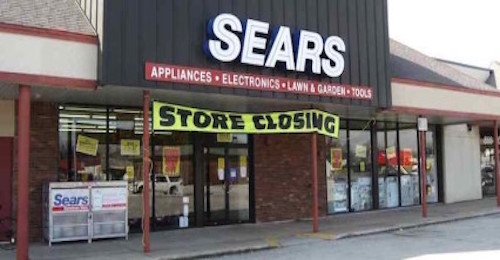This article was originally published in February 2015, then updated in October 2018 upon Sears filing chapter 11 bankruptcy.
In a recent article by Eric Englund, Stock Buybacks and Sears’ Death Spiral, published over at LewRockwell.com, the author discusses the fatal actions of former Kmart Chairman Edward Lampert, who became Chairman of Sears Holdings after Kmart’s acquisition of Sears in 2004:
“While front-line and backroom employees were doing their part, Eddie Lampert and Sears’ top executives were busy strip mining Sears’ balance sheet. Sears undertook stock buybacks, from 2005 to 2010, that totaled nearly $5.83 billion; meaning share repurchases exceeded profits, over this six-year period, by a little over $2 billion. Considering Kmart emerged from bankruptcy just 18 months before the acquisition of Sears, it seems counterintuitive for an executive team to willfully weaken Sears’ balance sheet instead of building as much financial strength as possible. Did Eddie Lampert, a Yale educated businessman, not learn any lessons from Kmart’s bankruptcy?
Well, the tough times came for Sears. This retailer lost $3.12 billion in 2011, $1.054 billion in 2012, and $1.116 billion in 2013. With big-box retailing being an ultra-competitive business, sound balance sheet management is critical. So why would a retailer’s management team knowingly weaken the company’s cash, working capital and equity positions; which is exactly what stock buybacks do. To me the answer is that short-term personal financial gain, for executives, trumped long-term strategic planning.”
“For the seven years Sears Holdings undertook share repurchases, the buybacks exceeded net profits in five of those years. This is what I mean by strip mining Sears’ balance sheet. Once management grasped the magnitude of the losses Sears was facing, the buybacks ceased; and should have never happened in the first place.
Through the third quarter of fiscal-year 2014, Sears Holdings’ net loss was $1.523 billion. And now, nearly ten years after Eddie Lampert’s triumphant acquisition of Sears, this retailer’s balance sheet is in tatters. As of the third-quarter ending November 1, 2014, cash stands at a paltry $326 million; working capital is negative $823 million while equity has nearly vanished and is merely $126 million. On top of this miniscule equity position stands a mountain of liabilities totaling $15.043 billion; leaving a mind-numbing total-liabilities-to-equity ratio of 119.4 to 1 (a ratio of 3 to 1 is considered to be a bit high and worrisome; so higher is not better).”
“Considering 2014’s anemic Christmas season, I predict Sears Holdings’ net worth will fall into negative territory when it reports fiscal-year 2014’s results. When a company has little cash, negative working capital, and a negative net worth, it is painfully insolvent. I also predict that when Sears declares bankruptcy, the talking heads on CNBC and Bloomberg TV will not call Eddie Lampert onto the carpet and question Sears’ reckless stock buyback program running from 2005 to 2011.”
So, that’s what was going on in the upper echelons of Sears; the corporate executives (which I prefer to call corporate politicians, for obvious reasons) were secretly stripping the company down to its bare bones, enriching themselves at the expense of the 130-year-old company—long a mainstay of American culture—until there was nothing left to pick from the bones, and the company collapsed into bankruptcy. Sad, yes—but far from surprising. We see this all the time in today’s dog-eat-dog business world. And—just like government politicians—we rarely, if ever, see corporate politicians go to jail for financially raping a company while systematically lying to its shareholders about it.
But in the case of Sears in particular, I’d like to once again—at the risk of being accused of beating a dead horse (or dead company)—toss my two cents into the discussion; for what was happening on the front lines at Sears—at the worker level, down at the bottom of the corporate ladder—in my opinion contributed just as much, if not more, to the death of the company as did the upper executive shenanigans.
I worked at a Sears hardware store back in 2007-2008; it was a stand-alone Hardware & Appliance store in Avon, Indiana (long since closed) located just west of Indianapolis. I had only applied for a part-time job, but during the interview, when my related knowledge and experience became apparent, I was hired on the spot, full time. Two weeks later, I was promoted to Tools & Hardware Lead, and shortly thereafter was moved into shift management, opening and closing the store, running shifts, etc.
By treating my co-workers with the utmost respect, I in turn garnered their respect, and we quickly formed an effective, proficient team. I then focused on building a customer base, helping people find what they needed for their projects, advising customers on how to handle their projects, etc. During this time, I discovered a set of six 2-way radios shoved in the back of a cabinet in the office, dusty and unused, and brought them into service, giving one to each of my leads at the beginning of each shift. Now, instead of running all over the store like headless chickens trying to find each other, or to ask each other questions while assisting customers, we could all simply communicate via radio from anywhere in the store—including the store managers, who were typically either hiding in the office or standing around back in the warehouse or at the loading dock, smoking and jack-jawing.
Before long, I had repeat customers coming into the store and/or calling on the phone asking for me. Since we were located out on the edge of town—bordering on rural—and this particular facility specialized in tools & hardware, we had a strong base of DIY home improvement customers, contractors, and quite a few farmers. (I’ll never forget: after helping an old farmer to identify a piece of equipment he found in his barn and didn’t know what it went to (it was an arbor for his old drill press), he looked at my manager behind the counter, pointed at me out on the floor, and said loudly, “You guys NEED a guy like him here!” One of the biggest complements I’ve ever received!)
Regardless of all this, unfortunately, I was constantly in trouble with the company. See, I was so busy helping customers find (and purchase) what they were looking for, what they needed for their projects (whether they knew it or not coming in) I didn’t have much time for selling what Sears wanted me to sell. Fact was, Sears wasn’t interested in customer service, building a base of repeat customers, selling to customers what customers wanted to buy; Rather, Sears was interested in selling what Sears wanted to sell—a death wish by any measure.
Seriously—regardless of how well I was running the store, training my people, building a solid customer base, and increasing sales, I was literally yanked into the office regularly and scolded and/or written up for not “making my numbers” (by selling worthless extended warranties or merchandise replacement plans, or having people apply for a credit card—all of which nobody with any sense wanted or needed, but Sears wanted me to sell because they were high-percentage (in some cases 100%) profit items.
I was even directed to lie to customers, such as telling them they would receive a reminder call to schedule their annual in-home maintenance inspections on major appliances they purchased from Sears—a program which had long since been discontinued.
It wasn’t long before my mantra became: “The only people Sears treats worse than its customers are its employees!”
And my co-workers readily agreed with my assessment.
Though I loved helping people with their projects, the employment situation at Sears was one of the worst I’ve ever experienced—with the exception of perhaps Borders bookstore, and we all know how well that monstrosity ended (and, BTW—they were running their stores in much the same way as Sears—the main difference being that Borders idiotically handed their entire customer base over to Amazon, thus driving the stake into their own heart).
Sears, like Borders, was excessively top-heavy, as typically happens when a company (or any organization, association, corporation, government, etc.) becomes institutionalized, and thus loses sight of its original purpose. Being institutionalized means the company has become its own reason for its existence, and its own survival and thriving becomes its top priority—as well as the priority of its individual employees who have become dependent upon it—rather than serving or otherwise creating value for its customers, members, patrons, etc. which it was originally established to serve, and which made it successful in the first place. The phenomenon of institutionalization always spells slow death for any organization, and today we are seeing this phenomenon come to fruition society-wide—including (and especially) at all levels of government.
(For a more detailed analysis of the destructive nature of institutionalization, I recommend reading The Wizards of Ozymandias: Reflections on the Decline & Fall by Butler Shaffer).
An example: Sears had a team of high-salary executives/managers that incessantly traveled around visiting the stores, doing nothing but making life miserable for everyone that worked there (especially management) and soaking up any profits that guys like me might inadvertently be channeling into the company. I’ll never forget: I was working on erecting a set of heavy steel shelves, by myself, and one of these bigwigs walked up with his clipboard and was standing watching me (they loved work—could stand and watch it all day!) There was a stack of cardboard signage that had been leaning on one end of the display, and at some point had slid down onto the floor and into the aisle. This guy was literally four feet away from the pile on the floor, standing there doing nothing but holding a clipboard and looking important, when he called over to me—twenty feet away, bent over, hands full, working my ass off—and directed me to come over and pick the signs up off the floor in front of him. He stated something like “We should probably pick those up off the floor, before somebody trips on them,” to which I had to bite my tongue to keep from responding “Okay, I’ll hold your clipboard for you.” Instead, I stopped what I was doing, put down my tools, walked twenty feet over to him, and slid the signs back up into position, not four feet from where he stood and watched!
But back to Sears wanting me to sell what Sears wanted to sell, rather than what customers wanted to buy: when the managers or owners of a company become focused on the secondary objective of making money, you can rest assured: that company is doomed, management has lost its way. Because contrary to popular belief, a company’s primary objective is NOT to make money; rather, it is to provide value to, and serve, its customers. The money, or profit, is secondary—it’s how they gauge how successfully they are performing their primary objective of serving and providing value for its customers. (I’ve written of this in more depth here). Sears just wanted to make money; Sears was not interested in providing value to, or serving, its customers. But a successful business doesn’t work that way—and they are now seeing this reality, as bankruptcy looms.
Also, at the time, people didn’t realize that Sears had been acquired by Kmart in 2004, shortly after Kmart had emerged from bankruptcy. So, it’s no longer Sears, it’s Kmart. It’s not the Sears my parents’ generation, and their parents’ generation, had come to know and trust. And it was sad, as I watched members of these older generations come into the store, and I could tell they fully expected the old Sears—the quality goods, the quality service, the trustworthy reputation—only to be disappointed, perplexed, and typically leave with empty hands, never to return.
And I suspected that once those older generations of customers ceased shopping at Sears—either out of frustration or sadly as a result of attrition—then that would mark the end of the company. Little did I know then that those in the upper echelons—the executive management—was at the same time already hard at work cannibalizing the company from the top down.
Eventually, I’d had enough, and left the company. And funny—my manager, being the upright, virtuous man that he was, blocked me on Facebook after I quit! And another manager—a long-time friend and cohort of my manager—was reportedly terminated by the company and personally escorted from his store by security, allegedly for employee theft.
Wow—such grand company I was keeping while employed with an organization that was rife with incompetence, ineffectiveness, disingenuousness, and outright criminality!
And since the time of my judicious exit, Sears has been closing stores across the nation (Sears Holdings also owned The Great Indoors, but closed all of those stores between 2005 – 2012).
And now—as I speculated would happen, just a few short years ago—Sears (which at one point was Amazon, before Amazon) has gone bankrupt.
Surprise, surprise.
Like/Follow Lifeology Blog on Facebook • View Rand’s Books on Amazon
Visit Lifeology Store • Like/Follow Lifeology Store on Facebook
A Note To Readers:
If you found this article (or any of the others, for that matter) interesting, informative, entertaining, etc., please consider subscribing to the Lifeology email newsletter: simply enter your email into the form below (also in the right sidebar)—or, if you prefer, just use this simple quick sign-up form.
↓↓↓ Also, please hit the “Like” (thumbs up) button below. Thanks! ~ Rand

















